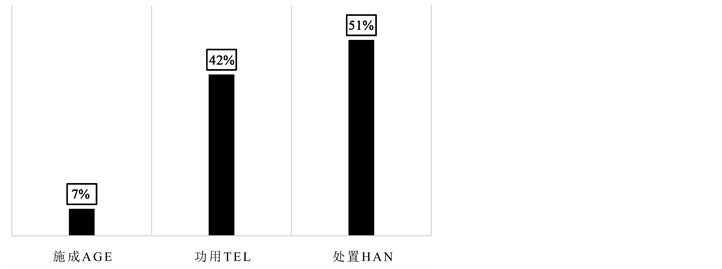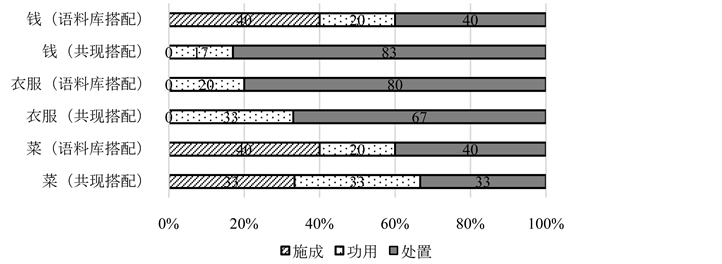1. 引言
词语搭配是汉语学习者的习得难点,而汉语作为第二语言的词语搭配研究成果在数量上不多,基于语料库数据的实证性研究成果尚不多见。我们认为,掌握教材中汉语词语搭配的概貌,有助于了解学习者词语搭配学习的实际情况,在此基础上才能系统的安排词语搭配的教学内容,建立高效的词语搭配教学模式。本文基于日本本土初级汉语教材、以物性结构和词语搭配统计指标为依据进行了一次尝试性的动宾搭配考察。
2. 研究背景
2.1. 词语搭配的统计方法和统计指标
2000年以来,借助语料库,以大量实际使用的语言为依据的词语搭配研究备受关注,出现了一些基于统计模型的词语搭配自动获取方法。孙茂松等(1997) [1] 借鉴了国外在语言学和语料库语言学两个方面关于词语搭配的研究成果,提出了包括强度、离散度及尖峰值三项统计指标在内的搭配定量评估体系,构造了相应的搭配判断算法。卫乃兴(2002) [2] 讨论了语料库证据支持的词语搭配研究的基本方法和主要原则。邓耀臣(2003) [3] 重点介绍了词语搭配研究中常用的三种统计方法,特别是对常见的MI值和T值的计算方法做了详细的介绍,并对比分析了每一种方法的优点和缺点。
2.2. 物性结构及物性角色分类
“物性结构”(Qualia structure)的概念早起源于古希腊哲学家亚里士多德的思想,他认为物体的性 质构成包括四个方面的因素,即形式因、质料因、目的因和动力因。在现代语言学中,物性结构理论是由生成词库理论的创始人,美国布兰代斯大学计算机科学系教授James Pustejovsky在他1995年出版的《The generative lexicon》(Pustejovsky, 1995) [4] 一书中提出的。物性结构描写与事物密切相关的属性,包括四个层面的知识:构成角色(constitutive role)、形式角色(formal role)、施成角色(agentive role)和功用角色(functionrole)分别描写事物与其组成部分之间的关系,上下位义关系(包括方位、大小、形状等信息),事物是怎样形成或产生的,事物的目的(purpose)和功能(function)。物性结构之于名词,就像论元结构之于动词,物性结构决定了名词的语义,就像论元结构决定了动词的语义。袁毓林(2014) [5] 根据汉语名词在文本中基本的组合方式、搭配习惯和语义解释,提出了汉语名词物性结构的描写体系,定义了十种物性角色(形式、构成、单位、评价、施成、材料、功用、行为、处置和定位)。根据选择性约束的观点,动语素有选择地约束名语素的不同物性角色,修饰名语素的不同方面。动宾搭配的物性修饰关系一般有三种,施成关系、功用关系和处置关系。分别指动语素修饰名语素的施成角色、功用角色和处置角色。
根据袁毓林(2014),物性结构知识库以名词为主要描写对象,通化过对名词相关语义和句法信息的描写,构建属性、动作和事物之间相互关联的语义网络。这一做法不同于VerbNet、FrameNet等以动词为核心的知识库构建体系,在一定程度上是对动词句法语义信息描写的补充。在物性结构知识库中,相同的语义信息是不同的词语相互关联的纽带,知识库网络的构建得益于这些具有链接作用的语义信息。物性结构知识库一方面关注不同概念之间基于世界知识的语义联系,同时也注重词语之间的组合关系尤其是各种不同物性角色与名词在句法配置上的组合信息。
3. 研究目的
本文基于日本本土初级汉语教材、以物性结构和词语搭配统计指标为依据,以HSK1、2级名词为对象,主要探讨日本本土初级教材中的高频动宾搭配有哪些,这些动宾搭配的物性修饰关系的比例如何,并通过考察语料库中的词语搭配统计指标,对比分析教材中和语料库中的高频动宾搭配在物性结构上有何差异,以期帮助学习者掌握各名词主要凸显地物性角色,更好地掌握语言规律。
4. 日本本土初级教材中的高频动宾搭配及其物性修饰关系
4.1. 教材选定
本次调查中收集的8本教材均为日本各大学汉语专业近年(2010年~2016年)使用的一年级教材,将所有教材进行扫描,通过OCR制成电子文本,用以统计(表1)。

Table 1. 8 textbooks of the object of study
表1. 考察对象的8本教材
4.2. 初级本土教材中动宾搭配的共现情况
选取HSK的1、2级名词,去除人际关系名词、时间名词、地点名词和方位名词后,共计57个,其中1级25个、2级32个。我们首先考察了57个名词在8本教材中的搭配情况,发现了其中由34个名词(下文简称为节点词)组成的58个动宾搭配共现于两本以上(含两本)教材中(下文简称为共现搭配)。34个节点词为:菜、茶、出租车、电脑、电视、电影、东西、飞机、汉语、米饭、名字、苹果、钱、书、水、水果、衣服、桌子、字、报纸、船、公共汽车、咖啡、课、路、门、牛奶、票、生日、问题、西瓜、雪、药、自行车。58个共现搭配为:做菜、吃菜、点菜、喝茶、坐出租车、买电脑、玩电脑、看电视、看电影、买东西、吃东西、坐飞机、开飞机、说汉语、学汉语、教汉语、学习汉语、吃米饭、起名字、吃苹果、买苹果、花钱、取钱、要钱、换钱、找钱、借钱、看书、买书、喝水、吃水果、洗衣服、穿衣服、买衣服、擦桌子、写字、念字、看报纸、坐船、晕船、坐公共汽车、喝咖啡、下课、上课、走路、开门、出门、敲门、喝牛奶、买票、订票、过生日、问问题、解决问题、吃西瓜、下雪、吃药、骑自行车。
4.3. 共现搭配的物性修饰关系
我们依据袁文(2014)中陈述的动宾搭配的物性修饰关系和名词物性结构数据库 [6] ,对57个动宾搭配进行分类(表2)。
5. 语料库中的高搭配频次、强度的动宾搭配及其物性修饰关系
5.1. 由共现搭配的名词组成的高搭配频次、强度的动宾搭配
典型搭配即母语语料库中经常出现的搭配。Hoey (2005) [7] 经过研究发现典型搭配是构成语言自然度的关键因素。学习者如果掌握了典型搭配,输出语言的自然度和流畅度就会增加,因此典型搭配在词语搭配习得中具有重要的作用。MI值是信息论中的一个概念,用来衡量两个事物的相关程度,在语言学中通常用来衡量两个指定的单词之间的可预见度(strength of association),即搭配强度。通过MI值可以找出出现频度低但黏着度高、特殊性大的搭配。根据Hunston (2002) [8] ,把MI值 ≥ 3的词,作为显著搭配词。基于以上理论,我们将本文考察的高频、高搭配强度规定为:同时满足搭配频次3次以上(含3次)、MI值 ≥ 3的搭配。
首先,在TORCH2009语料库1 [9] 中,我们统计出了与共现搭配中名词的搭配频次(Span:+/−4)居前五位、且MI值 ≥ 3的动词,共计83个,组成83个动宾搭配(下文简称语料库搭配)。详见表3。

Table 2. The verb-object of quale role in the Japan’s primary textbook
表2. 日本本土初级教材中共现搭配的物性修饰关系

Table 3. Node words in TORCH2009 with the strength of the top five with the verb (MI Score ≥ 3, Span: +/− 4)
表3. 节点词在TORCH2009中搭配强度居前五位的搭配动词(MI值 ≥ 3, Span: +/− 4)
5.2. 语料库搭配物性修饰关系
我们依据物性角色,对83个动宾搭配的物性角色句法结构进行分类,详见表4。
6. 物性修饰关系的对比分析
以下图1、图2分别为共现搭配中的34个名词在日本初级教材中的物性修饰关系比例和在TORCH2009的物性修饰关系比例。

Figure 1. The proportion of quale role in Japan’s primary textbook
图1. 日本初级教材中的物性修饰关系比例

Figure 2. The proportion of quale role in TORCH2009
图2. TORCH2009中的物性修饰关系比例

Table 4. The verb-object of quale role in the corpus
表4. 语料库中的搭配物性修饰角色
名词代表某种事物,具有指称功能,但没有陈述功能。然而凡是事物,一般都具有某种属性,换言之,名词隐含一定的性状义。而具有性状,就会有程度上的差别,但这种程度的差异不是显现在外,而是隐含的,需借助外力来使之显现,并且通过外力对自身的性状进行强化和凸显,使隐含的特征得以明朗化。图1和图2显示了施成关系、功用关系和处置关系三种修饰关系在日本初级汉语教材和语料库中的比例。两比例大致呈一致分布,其中处置修饰关系最多,占一半以上,在日本初级教材中占51%,在TORCH2009中占53%;其次是功用修饰关系,在日本初级教材中占到42%,而在TORCH2009中仅占33%;施成修饰关系最少,在日本初级教材中占7%,而在TORCH2009中所占比例是初级教材的2倍,为14%。其中,处置修饰关系中常见的动词有:吃、看、喝、坐;功用修饰关系中常见的动词集中于“买”一词。总体而言,对比图1和图2可以得知,在日本初级教材中,着重对名词的功用修饰关系进行描写。
以三个名词“钱”“衣服”“菜”为例说明,见图3。教材对“钱”的描述以处置关系为主,占83%,其中频次较高的为:“取”、“要”、“换”、“找”、“借”,而在语料库中,处置关系仅占40%,其中频次较高的为:“赚”、“挣”,由此可见,日本本土初级教材更重视日本学生初到中国时的情景会话的应用;对“衣服”的描述,与语料库(80%)相比,教材对处置关系的描写比例(67%)较少,但两者都集中在“穿”、“买”、“洗”几词,基本呈一致状态;再议“菜”一词,语料库中表示功用修饰关系的动宾搭配较少,仅20%,而教材则较突出这方面的描写,其比例占所有动宾搭配的33%,比例较高的为“做”、“吃”、“点”。
7. 结语
本文对比并分析了新HSK1、2级名词在8本日本本土初级汉语教材中出现的56个动宾V + N共现搭配,并与大规模母语语料库TORCH2009中的搭配情况进行对比。结果发现两点,第一,共现搭配中高频度、高强度搭配并非占多数,而且共现搭配的数量、复现率因教材而异,学习者利用不同教材习得的动宾搭配不尽相同、缺乏统一性;第二,在物性修饰关系比例方面,一方面,日本本土教材和TORCH2009语料库中的高频高强度搭配中表处置角色句法结构的搭配呈现出较一致的状态,另一方面,日本本土教材对动宾搭配的描述偏重于功用角色句法结构,而反映真实语言的语料库中高频高强度搭配略偏重于施成角色句法结构。在教材编写时,希望能多方面的汲取素材,更有针对性地展现各个名词的语义特征和凸显的物性结构。对于同一名词,在不同的学习阶段应该选取哪些修饰角色的动宾搭配搭配进行教授,还有待于今后进一步的研究。

Figure 3. Comparison of the quale role between the corpus and Japan’s primary textbook
图3. 语料库与初级教材中物性修饰关系的对比
致谢
本文是笔者将2017年6月4日于日本关西大学召开的日本中国语教育学会上口头发表的内容整理修改而成的,借此机会对给予笔者宝贵意见的各位师长、学友表示真挚的谢意。
NOTES
1TORCH2009语料库是由全国64所以上高校的115位老师和硕士生及博士生参与语料收集和校对,共同创建的现代汉语语料库。该语料库大小为1,087,619词,1,703,635字。该语料库中所收文本绝大部分为2009年出版。语料库的名称TORCH为Texts of Recent Chinese的缩略词。